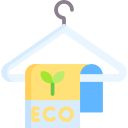
Sustainable Materials for Eco-Friendly Fashion
Sustainable materials are at the heart of a revolution in the global fashion industry. As consumers increasingly demand ethical and eco-conscious choices, brands are rethinking how garments are designed, produced, and worn. This page explores the most innovative sustainable materials, their benefits, and the movement toward more planet-friendly fashion. By embracing these alternatives, fashion is transforming into an industry that values both style and a smaller ecological footprint.
The Movement Toward Sustainable Fashion
01
Consumer Demand for Eco-Friendly Choices
Today’s consumers are more aware than ever about the environmental impact of their purchases. They seek brands that reflect their values, prioritizing eco-friendly materials and ethical supply chains. This growing demand for transparency is forcing companies to reconsider old methods and invest in innovative alternatives that minimize harm to the environment. Social media campaigns and documentaries have played a pivotal role in educating the public, driving consumers to seek out sustainable brands and hold others accountable for their practices. As this trend intensifies, the fashion industry is propelled toward meaningful change, ultimately benefiting both people and the planet.
02
The Importance of Material Innovation
Material innovation is crucial for the long-term sustainability of the fashion industry. Traditional textiles—especially those derived from petroleum or resource-intensive crops—often contribute to pollution, water scarcity, and habitat destruction. By focusing on alternative materials that use fewer resources and generate less waste, the industry is making strides toward a greener future. From lab-grown fibers to circular economies and upcycling strategies, innovation is leading the way in redefining how clothes are made. This spirit of creativity not only lessens environmental impact but also opens new doors for performance, style, and consumer choice.
03
Brands Embracing Sustainable Practices
Forward-thinking fashion brands around the globe are at the forefront of sustainable practices. They are overhauling production methods and sourcing, choosing environmentally friendly textiles, reducing waste, and implementing responsible labor policies. Many now disclose sourcing information publicly, making sustainability integral to their identities rather than a mere marketing tool. By setting ambitious goals—such as carbon neutrality, zero waste, or closed-loop manufacturing—these brands inspire others to follow suit. Their leadership is instrumental in mainstreaming sustainable materials and proving that eco-friendly fashion can be aspirational, accessible, and stylish.
Organic Fibers in Modern Apparel
Organic Cotton’s Eco Impact
Organic cotton is perhaps the most recognizable organic fiber in fashion, celebrated for its reduced environmental impact compared to conventional cotton. Organic cotton farming eliminates synthetic pesticides and fertilizers, greatly reducing water contamination and harm to local ecosystems. It promotes healthier working environments for farmers and often utilizes crop rotation and composting to maintain soil fertility. The result is a fiber that’s soft, breathable, and gentle on the skin—with less cost to the planet. As demand for organic cotton rises, brands and suppliers are increasing their certified offerings, making it easier than ever to wear environmentally responsible clothing.
Linen: Ancient Fiber, Modern Sustainability
Linen, derived from the flax plant, is prized not only for its elegance and comfort but also for its sustainability. Flax requires less water and fewer chemical inputs than many other crops, making linen a low-impact fiber suitable for eco-friendly apparel. Linen garments are biodegradable, durable, and naturally antimicrobial, offering versatile style from breezy summer dresses to structured shirts. Its rapid growth cycle and ability to thrive in less-than-ideal soil add to linen’s sustainability. Today’s designers value linen for its timeless appeal and minimal ecological footprint, with modern processing methods enhancing softness and wearability.
Hemp’s Resurgence in Eco-Fashion
Hemp is experiencing a powerful revival in the fashion world due to its impressive sustainability credentials. As one of the fastest-growing plants, hemp requires minimal water, pesticides, and herbicides, while actually improving soil health through phytoremediation. Hemp fabric is strong, breathable, and naturally resistant to mold and ultraviolet light. This makes it ideal for durable, comfortable clothing that maintains its quality over time. The versatility of hemp allows it to blend easily with other fibers, enhancing texture and performance. With growing acceptance and improved processing techniques, hemp is swiftly shedding its outdated stigma and establishing itself as a modern, eco-conscious choice.
The Rise of Recycled Materials

Innovative Recycled Polyester
Recycled polyester, often produced from used plastic bottles, exemplifies cutting-edge material innovation in fashion. Unlike virgin polyester, which is derived from petroleum, recycled polyester reduces dependence on fossil fuels and lowers greenhouse gas emissions. The process involves collecting and cleaning discarded plastics, breaking them down into pellets, and transforming them into new yarn. The resulting fabric matches the strength and versatility of traditional polyester while making significant strides in plastic waste reduction. Brands using recycled polyester help close the loop within the textile industry, offering stylish, high-performance garments that align with environmentally conscious values.

Closing the Loop with Recycled Cotton
Recycled cotton is another game changer, as it gives new life to pre- and post-consumer textile waste. The process begins by collecting discarded cotton garments and textile scraps, which are then sorted, shredded, and respun into fresh yarn. This approach conserves water, decreases chemical use, and limits landfill accumulation. While recycled cotton may sometimes need to be blended with other fibers to ensure durability, advances in recycling continue to improve the texture and strength of these eco-friendly textiles significantly. As more brands explore circular fashion, recycled cotton will play an increasingly vital role in reducing fashion’s footprint.

From Ocean Waste to Wearable Fabric
Transforming ocean plastic into wearable fabrics is one of the most exciting developments in sustainable material science. Fishing nets, plastic bottles, and other marine debris are collected, processed, and spun into innovative yarns such as ECONYL® and SEAQUAL. These recycled fibers are then used to create swimwear, activewear, and even luxury fashion pieces. The process not only cleans up oceans but also provides brands and consumers with high-quality alternatives to virgin synthetics. By supporting such initiatives, fashion enthusiasts can participate in ocean conservation and make a powerful statement for sustainability every time they get dressed.
Plant-Based Alternatives to Leather
Pinatex: Pineapple Fiber Leather
Pinatex is a pioneering plant-based leather made from pineapple leaf fibers, a byproduct of pineapple farming. Its production utilizes agricultural waste, providing farmers with additional income and eliminating the need for extra land or resources. Pinatex is lightweight, flexible, and breathable, lending itself well to shoes, bags, and accessories. The manufacturing process employs non-toxic chemicals and finishes, resulting in a low-impact material that offers the appearance and durability of traditional leather. As brands adopt Pinatex, they demonstrate a commitment to responsible sourcing and innovation, appealing to eco-conscious consumers worldwide.
Cork: Naturally Renewable and Versatile
Cork is another impressive plant-based material gaining traction in sustainable fashion. Harvested from the bark of cork oak trees without harming the tree itself, cork is endlessly renewable and supports thriving ecosystems. The material is naturally water-resistant, lightweight, and durable, making it an ideal alternative for footwear, wallets, and bags. Cork’s unique texture and ethical credentials—no animals are harmed and minimal processing is involved—appeal to both designers and consumers looking for stylish, sustainable options. As cork’s popularity grows, it’s proving that nature’s solutions can outperform synthetic materials in both function and flair.
Mushroom Leather: Mycelium-Based Marvels
Mushroom leather, produced from the root structure of fungi called mycelium, is one of the most promising breakthroughs in sustainable materials. The process involves growing mycelium on organic substrates, which can be rapidly cultivated with minimal resources. The resulting material mimics the softness, appearance, and strength of animal leather and can be engineered to meet diverse aesthetic and functional requirements. Mushroom leather’s low-impact production, biodegradability, and versatility make it an attractive choice for forward-thinking brands. As research advances, mycelium-based leathers are poised to revolutionize vegan and sustainable fashion landscapes.
Regenerative Agricultural Practices
Healthy soil is the foundation of regenerative agriculture. Practices such as cover cropping, minimal tillage, and diverse crop rotations enhance organic matter in the soil, promoting resilience and nutrient density. As plants photosynthesize, they draw down carbon dioxide, which is then stored in the soil as organic carbon—a process known as carbon sequestration. By sourcing materials from farms that prioritize soil health, fashion brands can reduce their carbon footprints and support the ecological systems that underpin sustainable production. Ultimately, this approach benefits not just fashion, but also food systems and climate stability.
Regenerative agriculture fosters biodiversity by encouraging the planting of varied crops, integrating livestock, and maintaining natural habitats within agricultural landscapes. This diversity supports pollinators, restores wildlife corridors, and builds resilience against pests and disease—reducing the need for synthetic chemicals. For sustainable fashion, fibers grown in biodiverse environments are often of higher quality and more environmentally friendly. Brands that champion this approach help restore balance to ecosystems, ensuring the longevity of both the fashion industry and the planet’s natural resources.
Regenerative agriculture relies on the knowledge, dedication, and well-being of farmers. Brands that invest in these practices are also helping to improve the livelihoods of rural communities. Fair pay, capacity-building, and long-term partnerships empower farmers to adopt regenerative methods, protect their land, and pass sustainable practices down through generations. By telling the stories behind the materials and highlighting the people who grow them, sustainable fashion brands build deeper connections with consumers. This social responsibility is integral to the mission of creating a fashion industry that is restorative, inclusive, and equitable.

Water Use and Resource Conservation

Conventional cotton is notorious for its thirst: it can take thousands of liters of water to produce a single garment. In contrast, sustainable cotton initiatives use advanced irrigation methods, drought-resistant varieties, and rain-fed cultivation to lower water use dramatically. Drip irrigation, for example, delivers water directly to plant roots, limiting waste and evaporation. Certified programs also encourage water stewardship among farmers and factories, ensuring that clean water remains available for communities and ecosystems. These efforts collectively help reduce the industry’s water footprint and set a new standard for responsible production.
Certifications and Transparency in Material Sourcing
The Global Organic Textile Standard (GOTS) is one of the world’s most recognized certifications for organic fibers. It covers every stage of textile production, from harvesting of raw materials to chemical inputs, environmental management, and worker welfare. GOTS-certified products guarantee that cotton, wool, and other natural fibers are grown without synthetic pesticides, and that manufacturing processes meet rigorous ecological and social standards. By choosing GOTS-certified textiles, brands and consumers support transparent supply chains and foster global best practices in organic agriculture and responsible textile production.

